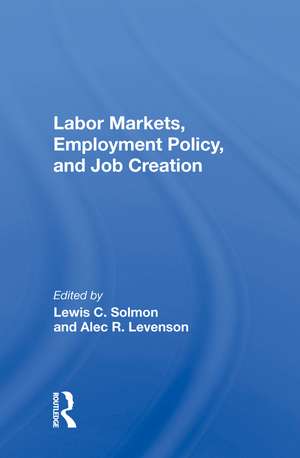Labor Markets, Employment Policy, And Job Creation
Editat de Lewis C. S. O. L. M. O. N.en Limba Engleză Hardback – 7 iun 2019
Preț: 773.51 lei
Preț vechi: 1108.25 lei
-30% Nou
Puncte Express: 1160
Preț estimativ în valută:
148.06€ • 160.88$ • 124.45£
148.06€ • 160.88$ • 124.45£
Carte tipărită la comandă
Livrare economică 21 aprilie-05 mai
Preluare comenzi: 021 569.72.76
Specificații
ISBN-13: 9780367016975
ISBN-10: 0367016974
Pagini: 440
Dimensiuni: 145 x 221 mm
Greutate: 0.97 kg
Ediția:1
Editura: Taylor & Francis
Colecția Routledge
Locul publicării:Oxford, United Kingdom
ISBN-10: 0367016974
Pagini: 440
Dimensiuni: 145 x 221 mm
Greutate: 0.97 kg
Ediția:1
Editura: Taylor & Francis
Colecția Routledge
Locul publicării:Oxford, United Kingdom
Cuprins
Preface -- Introduction: The Historical Context of Current Labor Market Debates -- Job and Skill Demands in the "New" Economy -- Introduction -- Job and Skill Demands in the New Economy -- Meeting the Skill Demands of the New Economy -- U.S. Education and Training Policy: A Re-evaluation of the Underlying Assumptions Behind the "New Consensus" -- Sources of Employment Growth: Sectors, Size, and Reasons -- Introduction -- Gazelles -- Small Business and Job Creation: Dissecting the Myth and Reassessing the Facts -- U.S. Productivity Growth and Its Implications for Future Employment -- Introduction -- Productivity, Employment, and Wages -- U.S. Productivity Revisited: It Remains Better Than You Think -- Government Mandates, Labor Costs, and Employment -- Introduction -- How Government Reduces Employment -- Observations on Employment-Based Government Mandates, with Particular Reference to Health Insurance -- Labor Force Demographics/ Income Inequalities/ Returns to Human Capital -- Introduction -- Relative Wages and Skill Demand, 1940–1990 -- Skills, Demography, and the Economy: Is There a Mismatch?
Descriere
The chapters tackle questions posed by job and skill demands in the "new high-tech economy" and explore sources of employment growth; productivity growth and its implications for future employment; government mandates, labor costs, and employment; and labor force demographics, income inequality, and returns to human capital.
